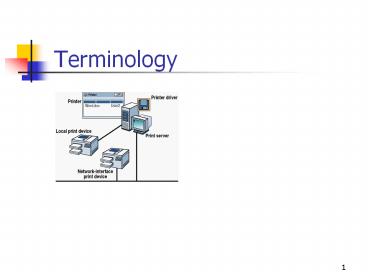Terminology - PowerPoint PPT Presentation
Title:
Terminology
Description:
Microsoft Windows 2000, Windows NT, Windows 98, or Windows 95 ... Automatically download the printer driver. Do not check for new printer drivers. ... – PowerPoint PPT presentation
Number of Views:15
Avg rating:3.0/5.0
Title: Terminology
1
Terminology
2
Requirements for Network Printing
- Print server
- Sufficient RAM to process documents
- Sufficient disk space on the print server
3
Guidelines for a Network Printing Environment
- Determine users printing requirements.
- Determine companys printing requirements.
- Determine the number of print servers required.
- Determine where to locate print devices.
4
Adding and Sharing a Printer for a Local Print
Device
- Starting the Add Printer wizard
- Log on to the print server as Administrator.
- Click Start, point to Settings, and then click
Printers. - Double-click Add Printer.
- Click Next to display the Local Or Network
Printer page.
5
Local or Network Printer Page
6
Add Printer Wizard Options for a Local Printer
- Local Printer
- Use The Following Port
- Manufacturers
- Printers
- Printer Name
7
Add Printer Wizard Options for a Local Printer
(continued)
- Default Printer
- Share As
- Location
- Comment
- Do You Want To Print A Test Page?
8
Adding and Sharing a Printer for a
Network-Interface Print Device
- In large companies most print devices are
network-interface print devices. - Advantage of network-interface print devices
- No need to locate print devices with the print
server. - Network connections transfer data more quickly
thanprinter cable connections.
8
9
Use Add Printer Wizard to Add Network-Interface
Printers
- When adding network-interface printers you must
specify additional port and network protocol
information. - The default network protocol for Microsoft
Windows 2000 is TCP/IP.
10
The Select The Printer Port Page
11
The Add Standard TCP/IP Printer Port Wizard
12
Setting Up Client Computers
- After you add and share a printer, you need to
set upclient computers so that users can print. - All client computers require that a printer
driver be installed. - The tasks to set up a client computer vary
depending on the installed operating system.
13
Microsoft Windows 2000, Windows NT, Windows 98,
or Windows 95
- Make a connection to the shared printer.
- Client automatically downloads the appropriate
printer driver.
13
14
The Locate Your Printer Page
15
The Browse For Printer Page
16
Clients Running Other Microsoft Operating Systems
- You must manually install a printer driver on the
client computer. - You get the printer driver
- From the installation disks for the client
computer. - From the printer manufacturer.
16
17
Clients Running Non-Microsoft Operating Systems
- Require additional services installed on the
print server. - Macintosh clients require Services for Macintosh,
which are included with Windows 2000 Server, but
not Windows 2000 Professional. - UNIX clients require TCP/IP Printing (Line
Printer Daemon (LPD) Service) included with
Windows 2000 Server. - NetWare clients require File and Print Services
for NetWare (FPNW), an optional add-on service
for Windows 2000 Server.
17
18
Client Computers Running Windows 2000
19
Search Active Directory Directory Services
20
Client Computers Running Windows NT 4, Windows
98, or Windows 95
- The Add Printer wizard allows you to
- Enter a UNC name for a printer.
- Browse Network Neighborhood to locate the
printer. - Use the Run command on the Start menu and type in
the UNC name of the printer.
20
21
Client Computers Running Other Microsoft
Operating Systems
- Windows 3.x and Windows for Workgroups use Print
Manager to connect to a printer - Use the following command
- net use lptx \\server_name\share_name
21
22
Using a Web Browser
23
Downloading Printer Drivers
- Clients running Windows 2000 or Windows NT
- Automatically download the printer driver.
- Verify current driver each time they print.
- If necessary download the current driver.
- You update drivers only on the print server.
24
Downloading Printer Drivers (continued)
- Clients running Windows 98 or Windows 95
- Automatically download the printer driver.
- Do not check for new printer drivers.
- You must manually install updated drivers on
clients. - You must manually install updated drivers on
print servers.
25
Sharing an Existing Printer
- Assign the printer a name.
- Appears in Network Neighborhood.
- Use an intuitive name for easy browsing.
- Add any needed printer drivers.
26
Using the Sharing Tab
27
Setting Up a Printer Pool
28
Advantages of a Printer Pool
- Can decrease the time that documents wait on the
print server - Lets you administer multiple print devices from a
single printer
29
Creating a Printer Pool
- In the Properties dialog box for the printer,
click the Ports tab. - Select the Enable Printer Pooling check box.
- Select the check box for each port to which a
print device that you want to add to the pool is
connected. - Click OK.
30
Setting Priorities Between Printers
- Can set priorities between groups of documents.
- Multiple Printers point to the same print device.
- Send critical documents to a high-priority
printer. - Send noncritical documents to a lower-priority
printer. - Set a different priority for each printer
connected to the print device.
31
Common Troubleshooting Scenarios
- Test page doesnt print.
- Test page or documents print incorrectly.
- Error message asks user to install a printer
driver. - Documents from one client computer dont print.
- Documents print correctly on only some print
devices in a printer pool. - Documents dont print in the right priority.



























![[PDF] Spanish Terminology for the Dental Team 2nd Edition Free PowerPoint PPT Presentation](https://s3.amazonaws.com/images.powershow.com/10100090.th0.jpg?_=20240816053)
![READ [PDF] Dental anatomy and terminology (Wiley self-teaching guides) PowerPoint PPT Presentation](https://s3.amazonaws.com/images.powershow.com/10126923.th0.jpg?_=20240909084)
![READ [PDF] Dental anatomy and terminology (Wiley self-teaching guides) (1) PowerPoint PPT Presentation](https://s3.amazonaws.com/images.powershow.com/10126940.th0.jpg?_=20240909089)

